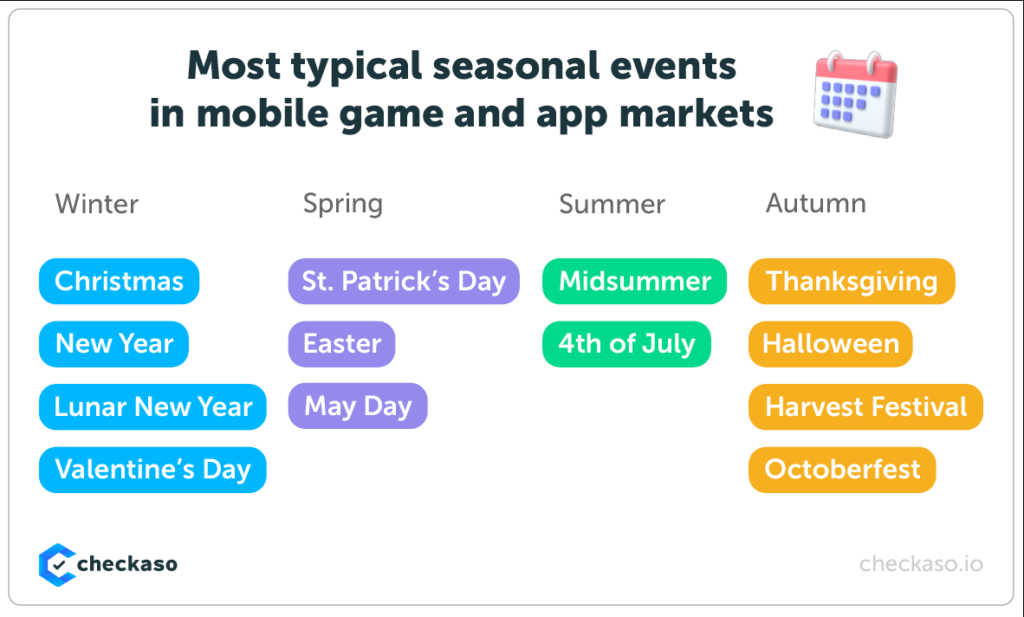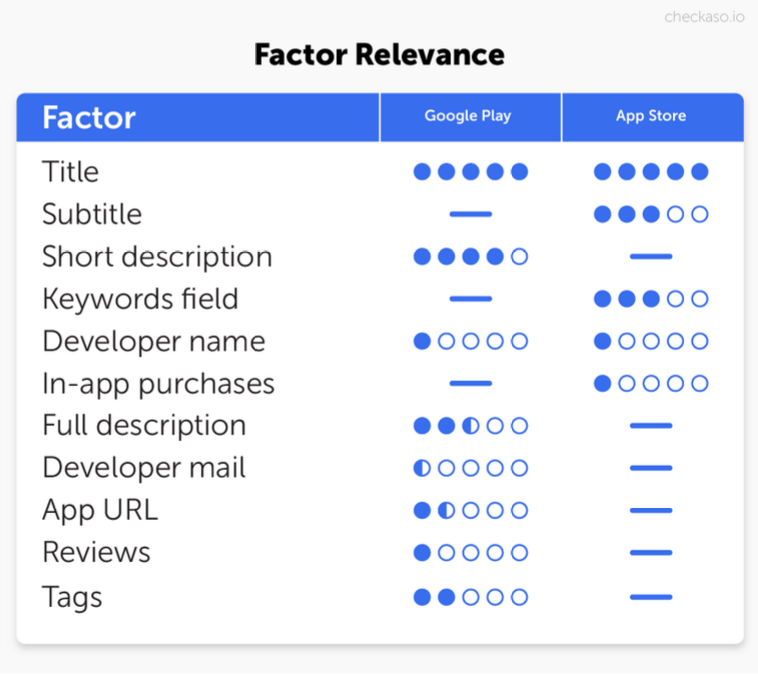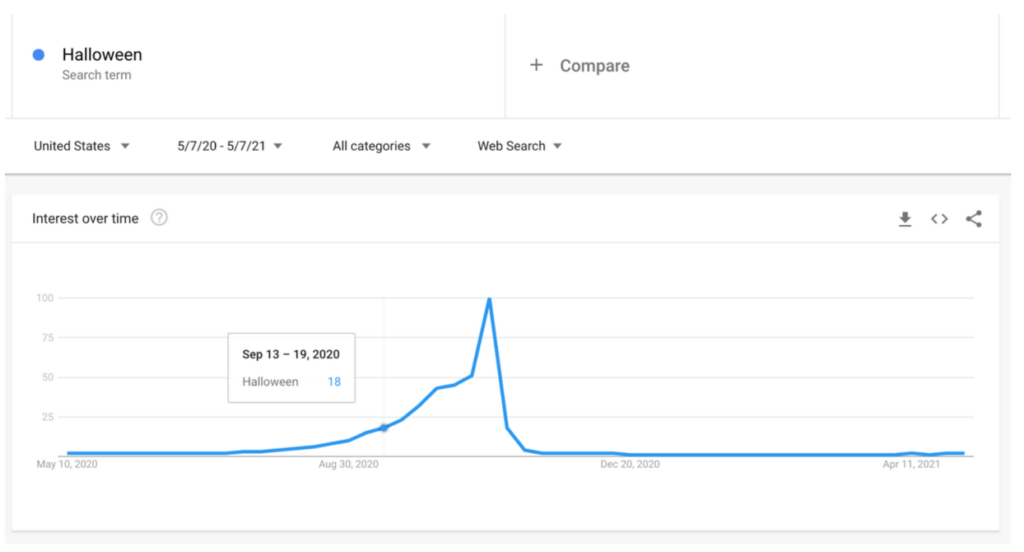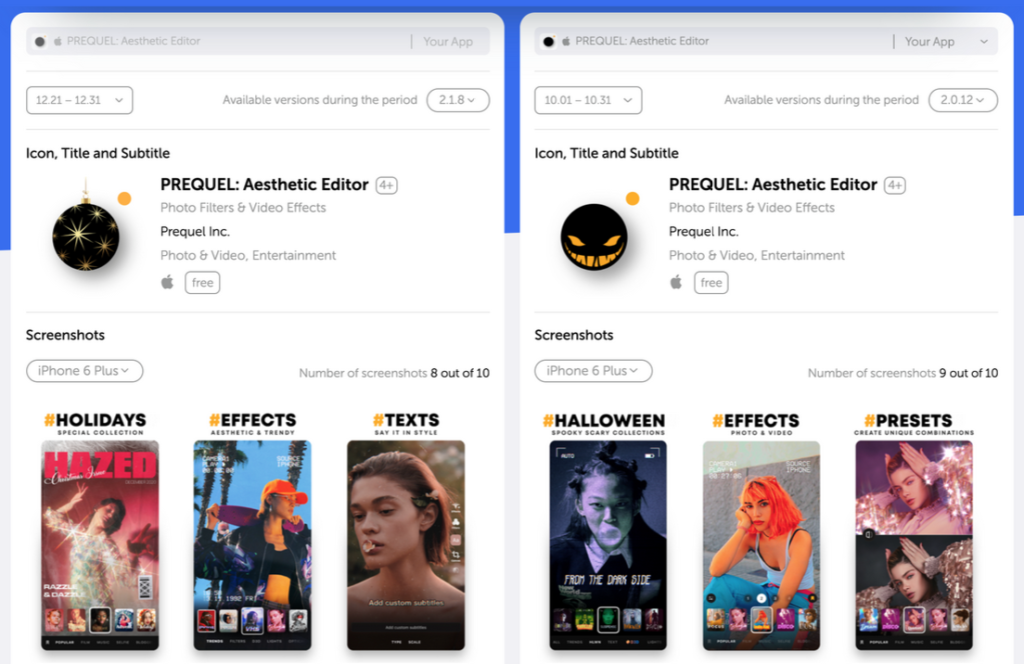How to mix holiday marketing and seasonal ASO?
App Store Optimization (ASO)
October 21, 2021
This is a guest post by Irina Heinz from Checkaso
Seasonal ASO is an additional way to boost app traffic. It helps to gain visibility in app stores and engage new users. Seasonal ASO is the optimization of the app product page that coincides with a recurring newsworthy event. It can be a holiday, a promotional event (Black Friday), or a high-profile international event like the Olympics.
Let’s explore what steps the seasonal ASO consists of and how to make it a part of holiday marketing to make the most of the New Year, Halloween, Valentine’s Day, and other events.
What does seasonal ASO consist of?
Seasonal ASO consists of visual and search optimization.
- Visual optimization is adjusting the graphics of an app product page to increase conversion. The main and least expensive way is to create holiday-themed icons and screenshots;
- Search optimization is adding relevant keywords related to events to indexed text fields.
Seasonal ASO shows if the app is relevant. Creatives help to engage new users and re-engage old ones. It can be argued that such campaigns are short-term, and the result is difficult to predict, yet a high-quality ASO increases installs and conversions. If the seasonal ASO promotes product changes, the traffic increase will be more significant. For example, a high-quality update timed to Black Friday at Cloud Mail.ru showed that installs grew by 38%.

Step 1: create a calendar of all events
Marketing activities are easier to plan if you have a seasonal calendar. Its final form depends on a number of factors:
- Target market.
- Specifics of the app.
- Team resources.
If your team is small, it’s best to focus on big events. Let’s say New Year and Halloween will be of great importance for mobile games. Special event content is often prepared for them: new levels, tasks, characters. A few examples: Subway Surfers, Fruit Ninja, Angry Birds, Temple Run, Hidden City, My Talking Tom, Draw Climber. Almost all top games leverage seasonality. Indie teams should embrace it too.
For branded and delivery apps, apart from the winter holidays, it’s better not to ignore Black Friday and Valentine’s Day. And for sports apps, events like the FIFA World Cup and the Olympics will be crucial. Also, the list of seasonal events may vary depending on the target country. For example, Thanksgiving will be one of the big events for the USA, St. Patrick’s Day — for Ireland, and Oktoberfest — for Germany.

Keep in mind all this when preparing the calendar of events. For your convenience, you can add activity ideas and approximate deadlines right away. Think about the events for which you should create additional content for your app. Calculate how long it will take to develop. If you create new characters or locations, it can take up to six weeks. In some cases, optimizing the app product page and adding small UI changes are enough. For example, adding a text field for promo codes is likely to take a few days. It is worth finding the time to create updated graphics for the product page, edit and test it.
Step 2: do research and prepare for the update
Research is half the battle. Observe trends and study the dynamics of the popularity of relevant keywords (Search Volume). You can analyze how the frequency has changed over the same period last year. This way, you can pre-select a pool of relevant keywords for search optimization and prepare new text metadata.
Search (Text) Optimization is the process of adding keywords to the product page metadata. This includes the app name, subtitle, short description, and keyword field. Elements and their effect on ranking are specific to each app store.

The user types in a query and finds the relevant apps. If your app doesn’t show up in search results for relevant keywords, you are losing organic traffic.
When to release an update? This is a hot issue, given the short-term nature of the event activities. We recommend checking Google Trends data for the same period last year. For example, in 2020, the popularity of the ‘Halloween’ query in the US began to skyrocket after October 17th. In the UK, an increased search interest occurred at the very beginning of October, then there was a slight decline, but its popularity peaked in mid-October.
Step 3: updating your graphics, metadata and content
Well, we have observed trends and set the deadlines, let’s get to work. Our work with the product team is well-coordinated, we perfect visuals and approve marketing and content. If the seasonal ASO is not a one-time promotion but becomes a long-term strategy, it will help you save resources in the future. The experience of the previous tests and analysis of the results will help you generate ideas faster and create more converting graphics. You can start small.
There are several basic strategies:
- If you do not have the resources for UI changes, you can simply make the holiday-related icon. It is cheap and risk-free, plus it will help attract users from the Browse/Explore, where the user often sees only an app icon. It is ideal for those who are short on time or inexperienced in seasonal ASO.
- You can announce special offers and optimize all creatives to boost them. Add at least one holiday screenshot to the top of the screenshot gallery. This is a common practice for shopping apps. In terms of development, it requires minimal effort.
- You can develop holiday content and update app icons and screenshots. It takes longer, and updates should be supported by marketing campaigns. If you are doing this for the first time, the results are difficult to predict.
Where can I find update ideas?
The easiest way is to conduct a competitive analysis. Analyze your competitors’ previous seasonal ASO. What strategy did they choose? How did they update the graphics? What news events did they cover? What seasonal keywords did they use in that period of time? How did all this affect the ranking in the app store?

Such research can be done in ASO services. In Checkaso, you can study visual changes of any apps, ranking dynamics, and observe a keyword rise and fall in popularity over time. If your competitors do not leverage seasonality, you won’t have additional information, but you’ll have an advantage. Plus, you can draw inspiration from other market niches.
What kind of special content can you offer users?
If you’ve decided to optimize not only the text metadata and graphics but also the content of your app, we have a few ideas. Sure, it depends on the specifics of the app.
- Special offers, discounts, promo codes;
- New levels and characters — it’s relevant for games;
- Gifts that are available for a limited time;
- Seasonal filters, masks, fonts, if your app is a photo editor.
What activities can support seasonal updates?
If you update your app for some holiday, you can support the release with promotional activities. They can be internal (in app stores) and external (ad traffic and social networks).
Internal activities:
- Getting featured. Getting into Featured Apps on the App Store and Google Play boosts your traffic. Experts and developers recommend submitting an application for featuring six to eight weeks before your update.
- Promo in-app purchases. It’s an additional opportunity to promote seasonal options and a limited amount of characters, weapons and equipment (in terms of games).
- Apple Search Ads. Thanks to ASA, apps can appear at the top of search results for keywords. The advantage is that the ad looks native and can be displayed by the branded keywords of your competitors (if they leverage seasonality, embrace it). The Creative Sets tool will be also good for you. It allows you to make new ad variations and align screenshots to specific keywords. With ASA, you can test new graphics. We’ll come back to this later.
- Distribution on Google Play. LiveOps Cards is an exclusive service mainly for large developers. In the developer console, you can manage in-game events, which are displayed on the main page, the store listing and in updates. But this opportunity is rare — not all applications get approved.
External activities:
- Google Ads and Facebook Ads are some of the most powerful ways to attract users. It’s easy to set up ad campaigns, control budgets, make corrections and track results. You can choose a media buying method (CPI, CPC, CPM).
- In-ads. There are many in-app ad formats. For games, Playable Ads seem to be the most effective for seasonal ASO. Such creatives attract user’s attention and create an enjoyable user experience. Provide a snippet of gameplay with new content so that the user gets excited about the game and wants to install it.
- Influencer marketing strategy. The most popular platforms for this strategy are Facebook, Instagram, Twitter, TikTok, Snapchat, YouTube. It’s important that your product resonates with the blogger’s audience.
- Make an announcement on your website and social media. You can promote your social media announcements.
- PR. Paid and free ads on the relevant media platforms will help draw attention to your update.

Step 4: testing updates
Test when a holiday search query is on the rise on the app store. There are three basic methods:
- With metadata update (compare before and after). This is the easiest way, for which one week is enough. After updating the graphics, you need to analyze the conversion rate. Focus on organic traffic from Search (installs from search) and Impressions (installs from editor’s selections, top charts and similar apps).
- Using special tools (for example, SplitMetrics or Storemaven). Traffic for tests is paid separately, the data is fairly accurate.
- Using Search Ads (only on the App Store). This option works only for testing screenshots. Put your two ad campaigns to the test for one keyword (or keywords). The traffic will be almost identical. But in the first case, you have the standard set of screenshots, and in the second, you put the updated set up front. 2,000 impressions will be enough for small apps. Focus on your metrics.
All methods are quite effective. The first method is free and less representative. The third one is not standard A/B testing, the data may be less accurate than data obtained with the second method, but more accurate than the first. Moreover, when a campaign is properly managed, the investment will pay off.
Step 5: analyze the result
To measure the effectiveness of your seasonal ASO, you need to analyze these metrics:
- impressions;
- views;
- installs (which Channel brings the most);
- post-install actions (how targeted the traffic was);
- getting featured (maybe, you have managed to get featured several times).
Conclusion
Most likely, you will see that seasonal ASO is a great way to increase conversion in app stores and attract new audiences. With the right strategy, you have a real chance to rank for high-frequency keywords, engage new users and re-engage old ones.
About the author

- Engage, Retain, Earn: Growth Strategy for Game Apps [Based on Data] - 15 September 2022
- How to do App Store Optimization step-by-step: a full cycle of ASO in the App Store and Google Play - 9 August 2022
- The Importance of A/B Testing - 13 January 2022

